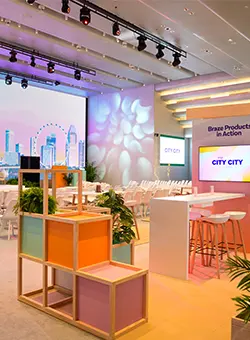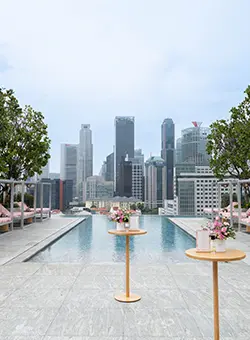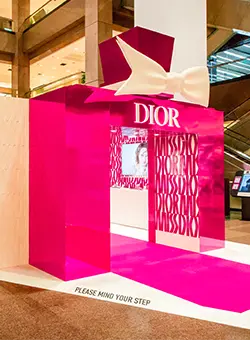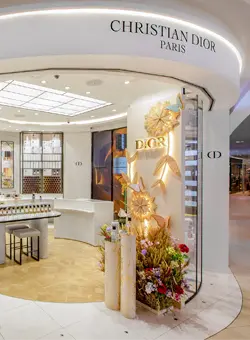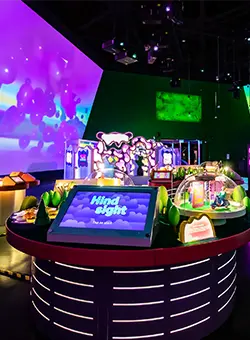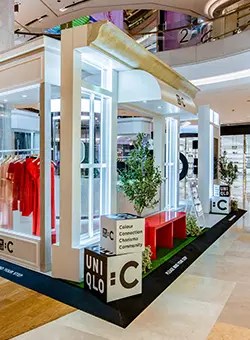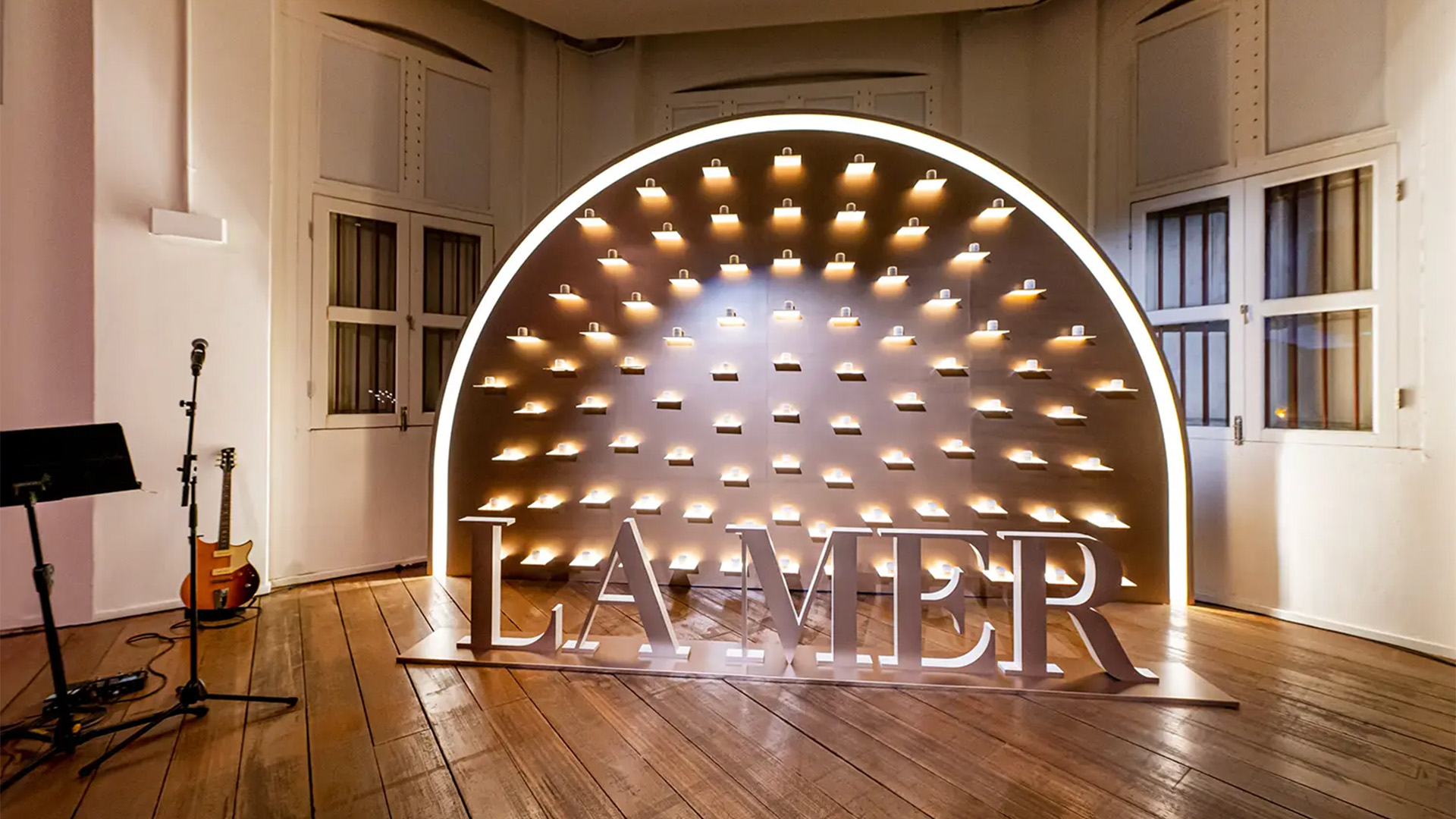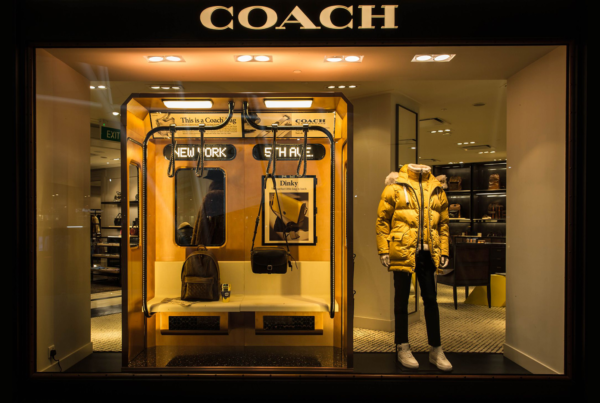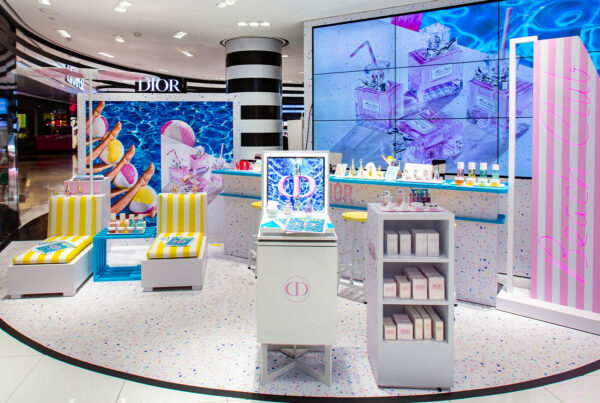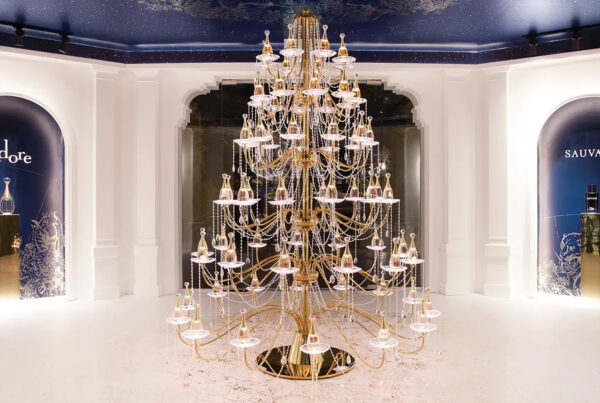Retail interior design has emerged as a powerful tool that shapes the way we shop, transforming brick-and-mortar stores into immersive spaces where every visit feels like an adventure. In the past, it was a simple transaction: customers entered a store, found what they needed, and left. However, the landscape has shifted dramatically, and shopping is no longer just about purchasing products. Today, it is an experience —a careful blend of aesthetics, ambience, and interaction. This transformation is not by chance but by design.
But what does this transformation entail, and how does it affect your business in Singapore? We will explore the impact of good retail interior design on your brand and your customers, and we will dive into the emerging trends that are shaping the retail landscape.
Part 2 – The Power of Retail Interior Design
2.1 Retail Interior Design and Its Pivotal Role in Shaping Customer Experiences
Retail spaces are no longer mere storefronts; they are meticulously curated environments where every element is strategically placed to engage, delight, and influence customers. Discover the significance of retail interior design and how it shapes customer experiences:
First Impressions Matter
In the world of retail, first impressions are everything. The moment a customer steps through the door, the store’s personality and values should be on display. This is where retail interior design comes into play. Elements like store layout, lighting, colour schemes, and signage work in harmony to convey a message. For instance, a well-designed entrance draws customers in and sparks their curiosity, making them more likely to explore further.
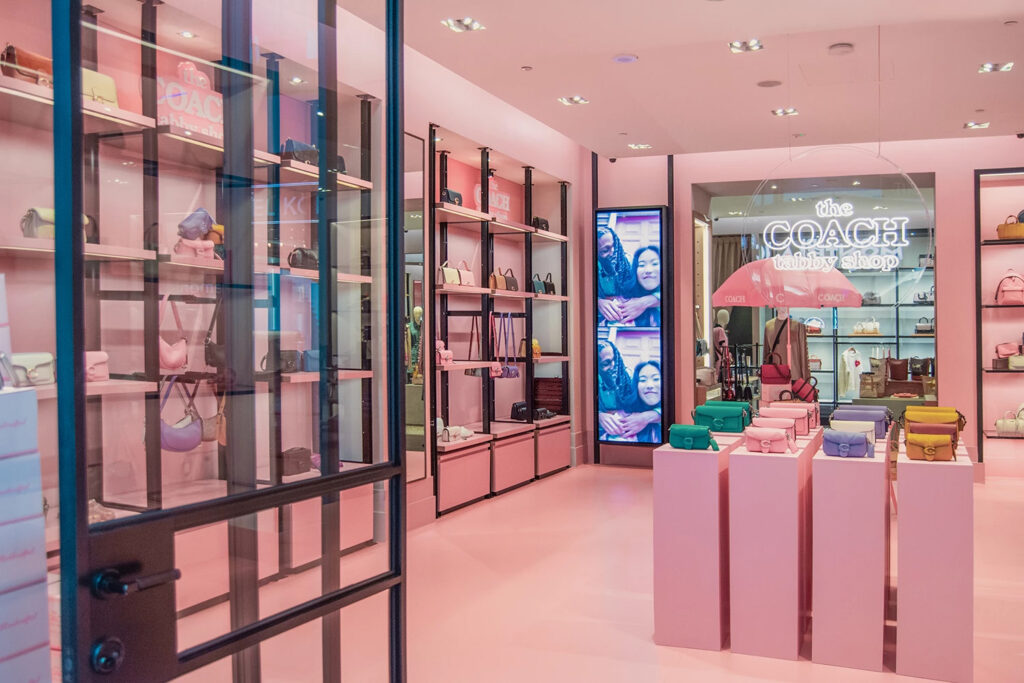
The Coach Tabby Shop is an illuminating example. The exterior was adorned in pristine bubblegum pink, while the interior fit-out was transformed into an enchanting ice cream parlour. A bespoke store window display and outdoor-inspired seating decor beckoned passersby, igniting their curiosity and encouraging them to embark on an exploratory journey within.
Navigating the Shopping Journey
Imagine a retail space designed to guide customers through a memorable journey. This can be achieved through effective retail interior design that ensures customers encounter key products or displays effortlessly. Wayfinding elements, aisle layouts, and visual merchandising displays all play crucial roles in making this journey intuitive and enjoyable.
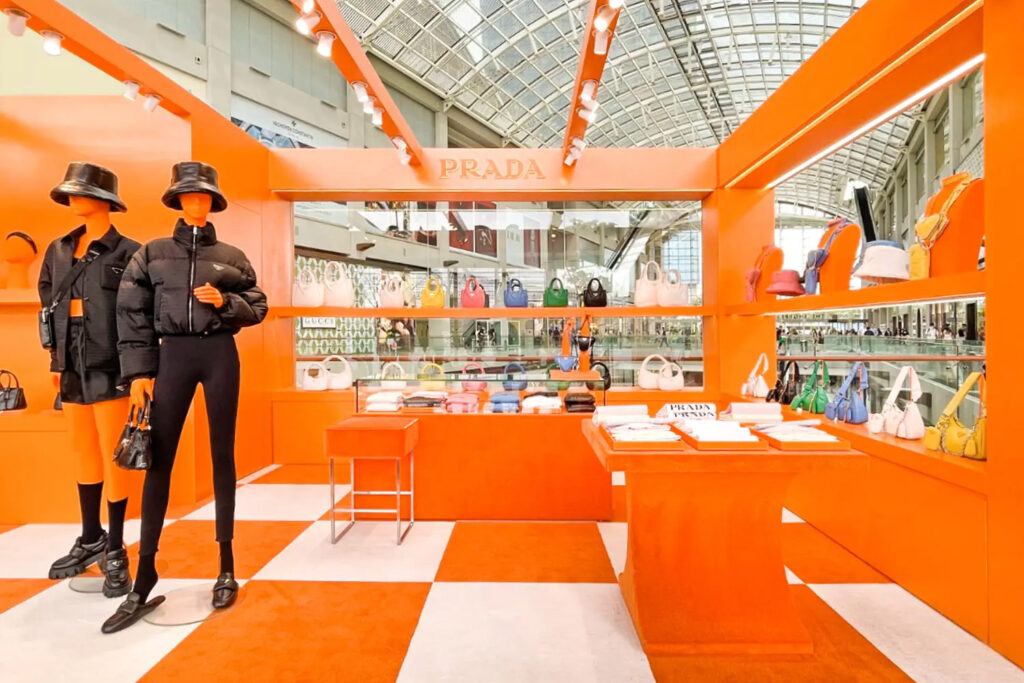
This was exemplified at the Prada Village Pop-Up, where eye-catching orange carpeting complemented the visual merchandising displays tailored to precise specifications, featuring a glass product presentation area accompanied by a sliding drawer and a casement door. Crafted with precision in timber frames, these bespoke visual merchandising displays were also constructed in varying sizes, all meticulously designed to spotlight the collection and guide customers to them.
Creating Emotional Connections
One of the secrets of successful retail interior design is the emotional connection it forges. Colours, textures, and materials are meticulously chosen to resonate with the target audience. The ultimate goal is to create an environment where customers feel not only at ease but also personally connected to the brand. It is about making customers feel like they belong and that the store is their space.
Enhancing Brand Identity
Every element in the store, from the decor to the choice of furniture, must align seamlessly with the brand’s values and message. Consistency in design elements is not just about aesthetics; when customers instantly recognise the brand’s personality the moment they walk in, a connection is forged. It instills trust and loyalty, transforming a store visit into an affirmation of the customer’s shared beliefs and aspirations.
Encouraging Interaction and Engagement
Successful retail interior design incorporates features like interactive displays, digital signage, and touchpoints that encourage customers to explore, learn, and interact with products. These elements turn shopping into a journey of discovery, making customers not just buyers but active participants in the store’s narrative.
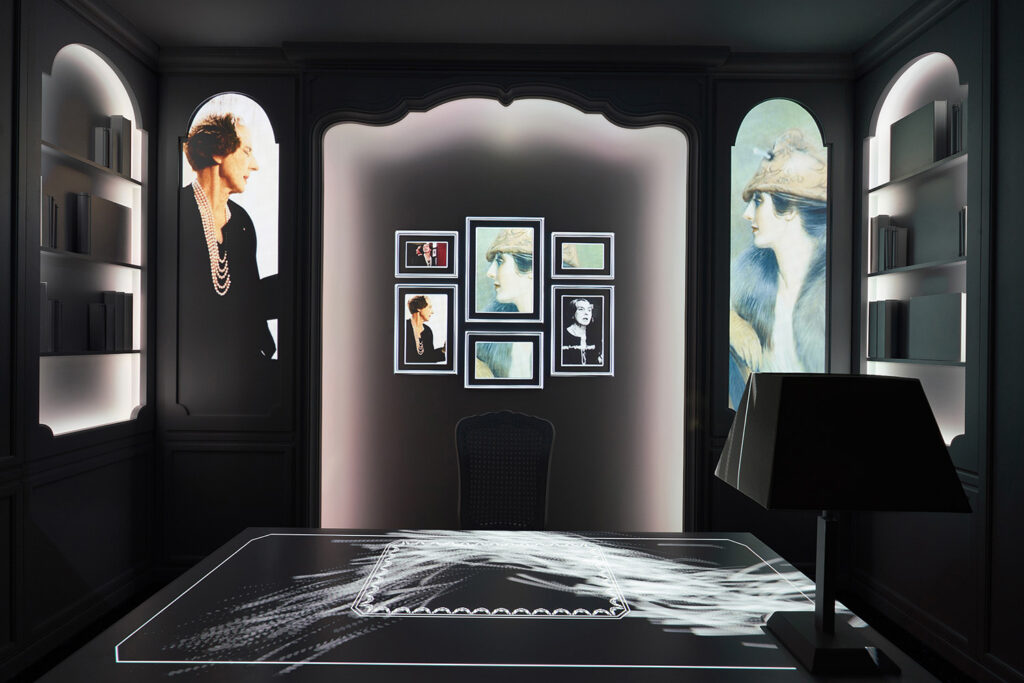
An excellent illustration of this concept can be seen in the Cartier ‘Into the Wild’ brand activation experience. A meticulously curated selection of interactive exhibits and dynamic video projections beckoned fans and loyal customers of Cartier to embark on an immersive exploration of the jeweller’s history.
The Influence of Technology
The digital age has ushered in a new era of commercial interior design. Interactive screens, augmented reality, and smart mirrors have become invaluable tools for enhancing the customer’s experience. They allow customers to virtually try products, access additional information, and immerse themselves in the shopping process. Technology creates a seamless and immersive shopping environment that blends the physical and digital worlds.
Flexibility and Adaptability
Retailers understand the need for change to keep the shopping experience fresh and exciting. This is where flexible retail interior design elements shine. The ability to transform displays, layouts, and themes quickly and cost-effectively is vital in an ever-evolving market, allowing stores to adapt to new trends, seasons, and customer preferences with ease.
2.2 Understanding Customer Behaviour and Preferences When Designing a Retail Space
As businesses seek to create engaging and successful retail environments, understanding customer behaviours and preferences has become paramount to creating a space that resonates with customers, guides their journey, and meets their needs. These are some critical aspects to consider when designing a retail space or pop-up store design:
The Customer-Centric Approach
Recognise that your retail space is not just a physical store; it is a platform for delivering an exceptional shopping experience tailored to your target audience. This approach shifts the focus from just selling products to crafting an environment that meets the unique needs and desires of your customers. It is about creating a space where they feel comfortable, inspired, and eager to explore.
In-Depth Market Research
Before you begin designing, gather comprehensive data on your customer base. This should include insights into customer demographics, psychographics, purchasing habits, and their specific preferences. This research allows you to pinpoint your ideal target audience and tailor your retail space to meet their specific requirements. This is the foundation for creating a retail space that resonates with the people you aim to attend to.
Understanding Customer Journeys
Mapping the customer journey is an indispensable part of retail interior design that guides customers seamlessly from entry to purchase. This process involves identifying key touchpoints, interactions, and decision-making moments that influence customer behaviour. It helps you anticipate their needs and preferences at each stage of their shopping experience, enabling you to design the space to facilitate their journey.
Store Layout and Flow
An effective store layout considers various factors that impact customer behaviour. This includes thoughtful product placement, aisle width, and the flow of foot traffic. A well-designed layout maximises the visibility and accessibility of products, making it easy for customers to find what they are looking for. It also encourages them to explore, potentially discovering items they did not initially intend to purchase.
Visual Merchandising
Putting together visual merchandising displays involves understanding customer preferences for product presentation, including colour schemes, lighting, and display design. These elements play a pivotal role in influencing purchasing decisions. For example, the use of warm and inviting lighting can create a cosy atmosphere, while vibrant colours can evoke excitement. Understanding these preferences can guide your visual merchandising strategy and enhance the overall shopping experience.
2.3 The Role of Design and Build Companies in Retail Interior Design
A design and build company plays a pivotal role in shaping the retail interior landscape, where aesthetics and practicality intertwine to create captivating and functional spaces. These firms redefine the retail experience, blending creativity with construction expertise to craft spaces that leave a lasting impression on customers.
Vision to Reality
A design and build company works closely with clients to translate ideas and visions into functional, real-world retail spaces. This encompasses interpreting design concepts, developing detailed plans, and overseeing the entire construction process. Their role is to bring the client’s dream to life, ensuring that it aligns with the brand’s identity and goals.
Comprehensive Planning
One of the primary responsibilities of a design and build company is to develop comprehensive plans that cover all aspects of retail interior design. This includes layout design, lighting, colour schemes, materials selection, and space optimisation. They ensure that every element contributes to a cohesive and compelling retail environment. Their expertise in both aesthetics and functionality allows them to create visually appealing spaces that resonate with the target audience.
Expertise in Aesthetics
A professional design and build company also understands the importance of aesthetics in attracting and engaging customers. Their specialisation extends beyond layout and decor to encompass vital components like visual merchandising and product display. These elements are strategically designed to enhance the overall shopping experience, making it more enticing and memorable for customers.
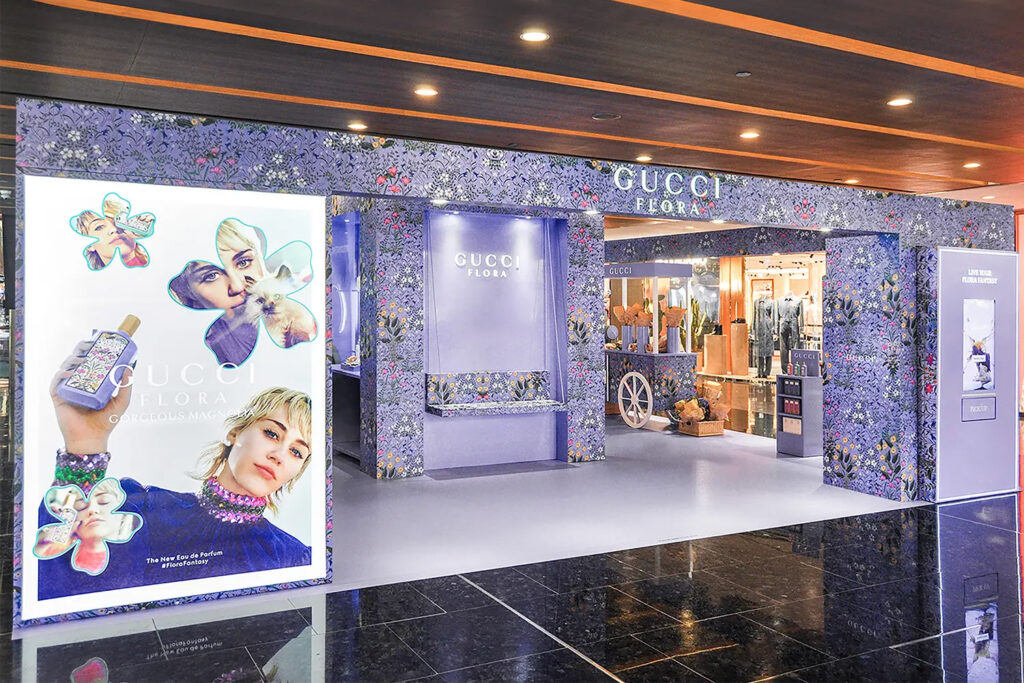
The prowess of a dedicated design and build company was showcased at the Gucci Flora Gorgeous Magnolia Pop-Up. The pop-up exploded in vibrant shades of eccentric lilac, artfully infused into various surfaces and features. The floral dreamscape extended seamlessly into the interior, transforming into a beauty make-up counter adorned with a mirror and a product display. Furthermore, every nook and cranny of the pop-up was thoughtfully designed to create an immersive and harmonious brand activation experience. Multiple touchpoints were strategically positioned, each featuring exquisite visual merchandising displays.
Technical Know-How
Beyond aesthetics, a design and build company can bring a wealth of technical knowledge to the table. They are well-versed in construction techniques, building codes, and industry standards. This ensures that the retail spaces they create are not only beautiful but also safe, functional, and fully compliant with regulations. It is about marrying creative vision with technical feasibility, achieving a space that meets a brand’s needs and is also structurally sound.
Project Coordination
A design and build company plays a central role in the coordination and execution of a project. They manage various aspects, including tracking timelines and overseeing construction activities. Their job is to ensure that the project progresses smoothly from conception to completion, and this requires excellent organisational skills, communication, and a sharp eye for detail.
Problem-Solving
In the course of a retail interior design project, unexpected challenges can surface. A design and build company excels at problem-solving, using their experience and expertise to find innovative solutions to overcome obstacles while maintaining the integrity of the design. They are adept at adapting to changing circumstances and ensuring that the final product reflects the original vision, even when facing unexpected roadblocks.
Part 3 – Achieving Successful Retail Interior Design
3.1 Tips for Creating Memorable Shopping Experiences With Retail Interior Design
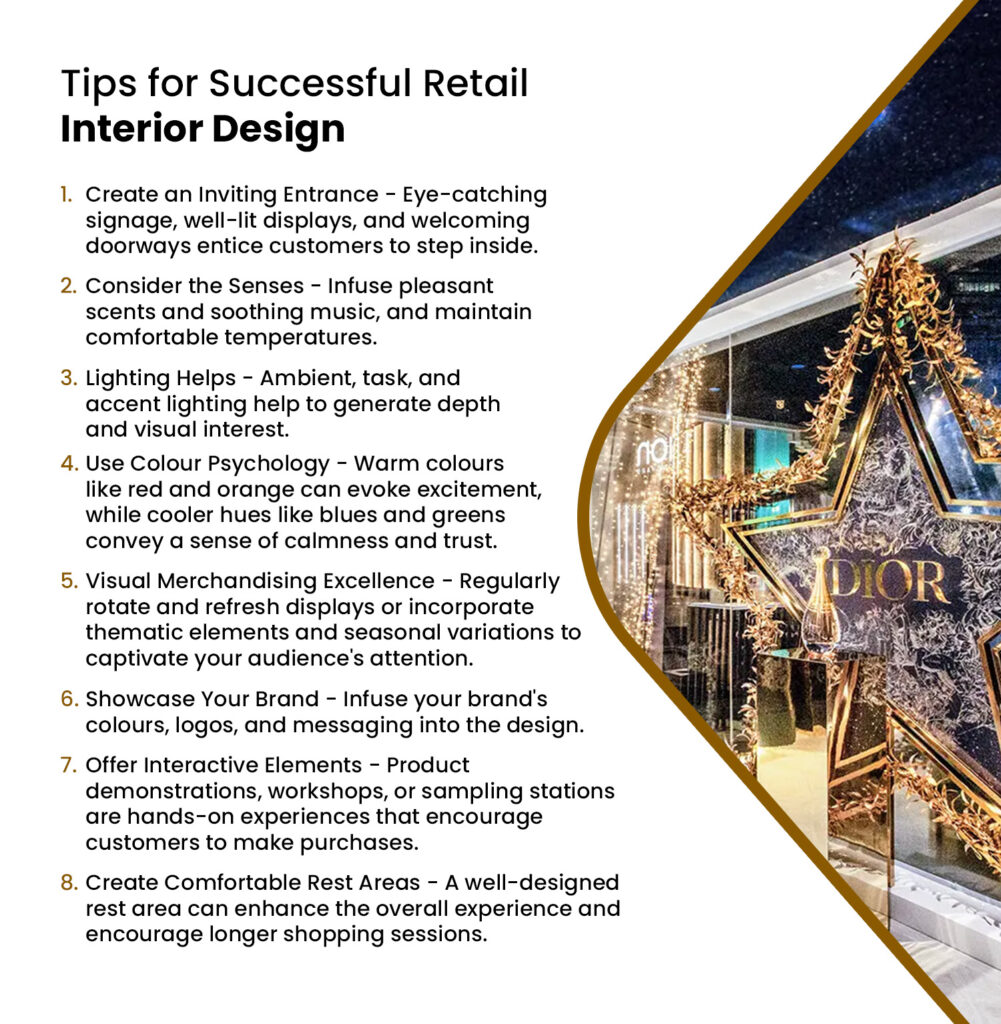
When it comes to enhancing your retail space and crafting unforgettable shopping experiences through retail interior design, there are several invaluable tips to keep in mind:
Create an Inviting Entrance
First impressions are important, and your store’s entrance sets the stage for the entire shopping experience. Whether you are managing a pop-up store or a brick-and-mortar shop, it is vital to ensure the entrance is inviting and visually appealing. Consider incorporating eye-catching signage, well-lit displays, and welcoming doorways that entice customers to step inside. The entrance should beckon customers, inviting them to embark on their shopping journey.
Consider the Senses
Engage all the senses to create an experience that lasts in the customer’s memory. Beyond visual appeal, think about how your store smells, sounds, and even feels. Consider infusing pleasant scents and soothing music, and maintaining comfortable temperatures to enhance the overall ambience. A multisensory experience elevates the ordinary into something truly extraordinary.
Lighting Matters
Lighting is an indispensable tool in retail interior design — it can be used to accentuate products, create focal points, and set the mood. Harness the power of lighting by utilising a combination of ambient, task, and accent lighting to generate depth and visual interest. Well-placed lighting can draw attention to key areas and products, while also influencing the overall atmosphere.
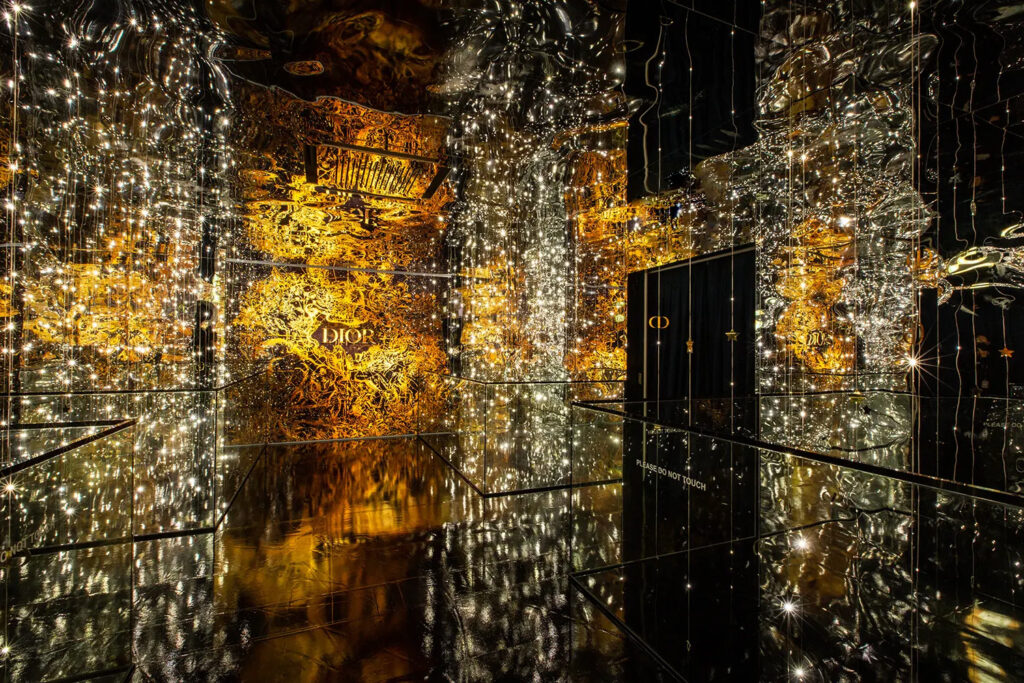
As an illustration, let us take a look at the Dior ‘The Atelier of Dreams’ brand activation event. In this enchanting setting, Christian Dior logo charms and stars were artfully showcased on individual hanging light strips. These exquisite accents were accompanied by fabric light box panels and dangling charms, casting shimmering reflections across the mirror-glass walls and ceiling panels. The effect was nothing short of magical, evoking a sense of starry winter nights that drew visitors into its irresistible aura.
Use Colour Psychology
Colours can significantly impact emotions and buying decisions, so it is important to consider the psychological influence of colours when designing your retail space. For instance, warm colours like red and orange can evoke excitement, while cooler hues like blues and greens convey a sense of calmness and trust. Thoughtfully chosen colours can influence customer perceptions and behaviour.

The La Prairie Cobalt Immersion Pop-up is the perfect example — renowned for its expertise in luxury anti-ageing skincare, the brand’s pop-up store design was immersed in its signature cobalt blue, creating an inviting and immersive experience. Visitors were welcomed to explore the extensive skincare range, and personalised consultations were readily available to empower shoppers with a deeper understanding of the products. The use of this distinct shade of blue was purposeful; not only did it enhance brand recognition, but it also evoked a sense of trust. La Prairie’s intent was clear: by using their products, customers could trust that they would achieve their desired results.
Visual Merchandising Excellence
Visual merchandising displays should not only be visually appealing but also convey a compelling story. To maintain customer interest, consider regularly rotating and refreshing displays or incorporating thematic elements and seasonal variations to capture your audience’s attention. Effective visual merchandising turns your products into captivating narratives that customers want to engage with.
Showcase Your Brand
Your store’s interior should be a reflection of your brand’s identity and values. Infuse your brand’s colours, logos, and messaging into the design to create a cohesive brand experience. Consistency in design elements builds brand recognition and trust, reinforcing the customer’s connection with your brand.
Offer Interactive Experiences
Engage customers actively by offering interactive elements within your store. Consider hosting product demonstrations, workshops, or sampling stations, as these hands-on experiences not only leave a lasting impression but also encourage customers to make purchases. Interaction creates a deeper bond between customers and your products.
Create Comfortable Rest Areas
Incorporate comfortable seating areas within your store to provide customers with a space for relaxation and reflection. These rest areas encourage longer shopping sessions, making customers feel valued and at ease. A well-designed rest area can enhance the overall shopping experience and foster a sense of comfort.
3.2 The Future of Retail Interior Design
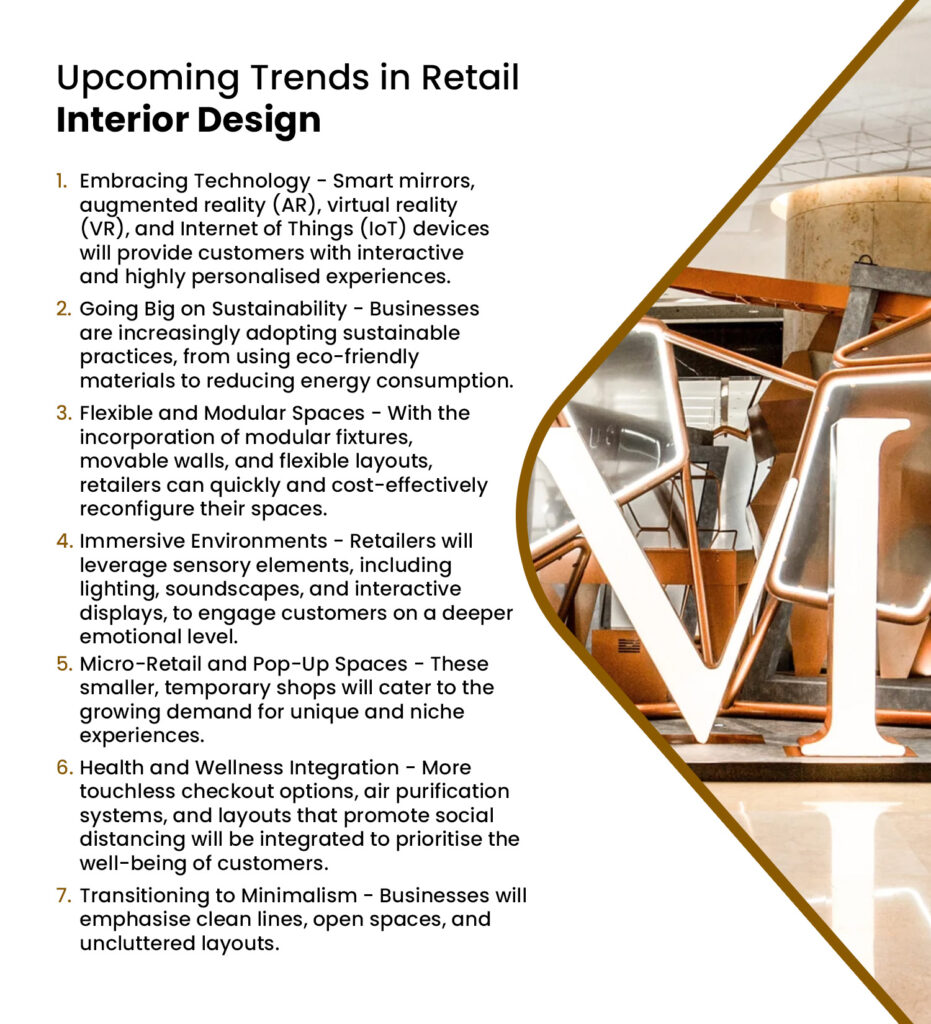
The future of retail interior design is a dynamic landscape that is evolving to meet the ever-changing needs and expectations of customers. Therefore, businesses must remain perpetually prepared to stand out from the competition. Here is a glimpse into the exciting possibilities and trends that are shaping the future of retail interior design:
Embracing Technology
Retail spaces are poised to become hubs of technological innovation. Smart mirrors, augmented reality (AR), virtual reality (VR), and Internet of Things (IoT) devices will provide customers with interactive and highly personalised experiences. Shoppers will be are now able to virtually try on clothing, access detailed product information through their smartphones, and receive tailored recommendations based on their individual preferences. Technology will bridge the gap between the digital and physical shopping worlds even more in the future, enhancing convenience and engagement.
Going Big on Sustainability
Environmental consciousness is a driving force in the future of retail interior design. Businesses are increasingly adopting sustainable practices, from using eco-friendly materials to reducing energy consumption. The emphasis on sustainability is not only a reflection of ethical values but also a response to the demands of eco-conscious consumers. It is no longer just about what you buy, but also where and how you buy it, making sustainability a significant consideration when designing a retail space.
Flexible and Modular Spaces
The retail spaces of the future will be adaptable and modular. With the incorporation of modular fixtures, movable walls, and flexible layouts, retailers can quickly and cost-effectively reconfigure their spaces to accommodate changing trends and seasonal demands. This flexibility allows for creative use of space, promoting innovation and diversity in the shopping experience.
Immersive Environments
The stores of tomorrow will fully leverage sensory elements, including lighting, soundscapes, and interactive displays, to engage customers on a deeper emotional level. Retail will slowly cease to be a mere transaction; it will be an immersive experience that leaves a lasting impact. Shoppers will be drawn into captivating narratives that extend beyond the products on display, fostering brand loyalty and unforgettable memories.
Micro-Retail and Pop-Up Spaces
The future of retail interior design will also see a surge in micro-retail and pop-up spaces. These smaller, temporary shops will cater to the growing demand for unique and niche experiences. They offer exclusivity, variety, and a sense of novelty, appealing to customers looking for something different and exciting.
Health and Wellness Integration
The post-pandemic era has ushered in a heightened focus on health and wellness in retail interior design. Touchless checkout options, air purification systems, and layouts that promote social distancing will be integrated to prioritise the well-being of customers. More and more health-conscious consumers will naturally gravitate towards spaces that make them feel safe and cared for.
Transitioning to Minimalism
Minimalism in retail design is about stripping away excess and focusing on the core elements that matter most. It emphasises clean lines, open spaces, and uncluttered layouts. In a retail context, minimalism seeks to create serene and purposeful environments that allow products to shine and customers to move freely without distractions. It is all about creating a sense of calm and clarity that enables customers to focus on what truly matters.
3.3 Answering Frequently Asked Questions about Retail Interior Design
Navigating the world of retail interior design can be both exciting and challenging. To shed light on the intricacies of this field, we have answered some of the most commonly asked questions about retail interior design:
How can retailers adapt their interior design to changing trends?
Retailers can adapt their interior design to changing trends by staying informed about industry developments, conducting regular store assessments, and being open to adjustments. Flexible store layouts and modular fixtures allow for quick updates to align with evolving trends and customer preferences. Customer feedback and market research are also valuable tools for staying up-to-date.
How can small businesses benefit from retail interior design?
Small businesses can benefit significantly from retail interior design by creating a distinctive and memorable shopping environment that sets them apart from larger competitors. Effective design can enhance the perceived value of products, improve customer engagement, and build brand loyalty. It does not necessarily require a large budget; even modest design improvements can make a significant impact on a small business’s success.
How does retail interior design differ from other types of interior design?
Retail interior design is distinct from other types of interior design, such as residential, because it is tailored specifically for retail environments. It takes into account factors like product display, traffic flow, customer interaction, and brand identity. The goal is to optimise the space for retail activities, sales, and visual merchandising.
Designing Experiences and Not Just Interiors
In the dynamic world of retail, where consumer expectations soar and competition knows no bounds, the significance of retail interior design has never been more apparent. As we have explored the impact of design and the emerging trends that shape the shopping experience, one thing remains clear: the power of design to captivate, engage, and leave an indelible mark on customers is undeniable.
The true measure of success in retail interior design is not solely in the aesthetics or functionality of a space. Rather, it is found in the delighted smiles of satisfied customers, in the loyalty of brand advocates who return time and again, and in the resonating stories told of well-crafted shopping experiences.
At Dezign Format, a design and build and experiential marketing company in Singapore, we are committed to bringing your unique vision to life. We understand that every detail matters, and we are here to transform your spaces into unforgettable, immersive, and revenue-boosting environments. We invite you to join us in creating retail experiences that will not only meet but exceed the expectations of today’s discerning shoppers.
Our team is also well-versed in conceptualising, designing, and fabricating a wide variety of exhibition booths for a diverse range of businesses.



